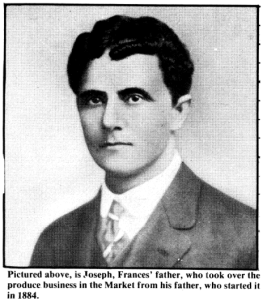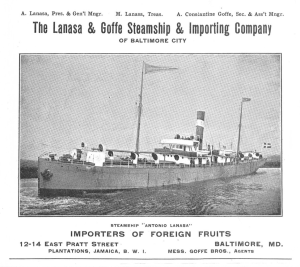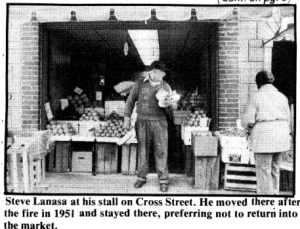 Lanasa Produce Family History
Lanasa Produce Family History
The Lanasa Family came to America in 1884 to seek their fortune. Michael Lanasa the first of the Lanasa Family brought his wife and seven year old son Joseph here from the fishing village of Termmi Immersi located on the southern coast of Sicily. Like many before him, he was a fish peddler but came to the Cross St. Market to begin his fruit and produce business.
In 1899 son Joseph went back to Sicily to marry his bride Josephine Sansone. The following March his brother Stephen went back to wed Josephine’s sister Rosina as was then the custom was marriages were arranged at birth. Around 1904 Joseph and his wife took over the business from Grandfather Michael to start a wholesale produce business at the busy Inner Harbor. At that time the Inner Harbor was the produce center for the state of Maryland. The Lanasas had gained the reputation in the business for being the first to import bananas to Baltimore and more importantly for discovering the processing of bananas. To make extra  money, Joseph became an auctioneer on the banana boats.
money, Joseph became an auctioneer on the banana boats.
Joseph and Josephine Lanasa had seven children: Michael, Helena, Marcus, Anna, Francis, Joseph and Tony. In October 1918, influenza took the life of Josephine leaving Joseph to care for seven young children. The Lanasa family had clearly established its roots in Cross St. Market and during the crisis of Josephine’s death the extended family lent their support. The Lanasa children were expected to do their fare share of helping. As soon as they were able to count bananas, oranges or apples-anything up to the count of 12, make a dollars worth of change, the children were recruited to work in the market. Francis at the age of 10, when her mother passed away began to help in the market. Her cousin Mary sold fruit in the market for her father Steve at the age of 6. Francis’s other cousin Steve started driving the delivery trucks at the age of 14. A day of work in the market would yield the children a dime or perhaps a quarter for spending money.
 The Lanasas earned their dollars the slow way, by long hours and hard work. Twelve hours was a short day and it just wasn’t the men working, the women worked side by side with the men all day. Then they would go home at night to cook and clean. Sunday, the day of rest, was for the women to spend the day preparing a dinner for the family Sunday gathering. A typical work day consisted of taking a bushel basket on your back and hustling produce. Then you would buy a pony and work out of a horse and wagon. Then from a horse and wagon you went to a little truck. You would wake up 2:30 in the morning and drive a wholesale truck to Jessup to stock up for the day. Back to Cross St. by 6:00 to unload the truck and set up the stand. Filling both wholesale and retail orders all day until 6:00 in the evening. They worked 10 hours a day, six days a week. This daily work schedule is followed til this day many generations later.
The Lanasas earned their dollars the slow way, by long hours and hard work. Twelve hours was a short day and it just wasn’t the men working, the women worked side by side with the men all day. Then they would go home at night to cook and clean. Sunday, the day of rest, was for the women to spend the day preparing a dinner for the family Sunday gathering. A typical work day consisted of taking a bushel basket on your back and hustling produce. Then you would buy a pony and work out of a horse and wagon. Then from a horse and wagon you went to a little truck. You would wake up 2:30 in the morning and drive a wholesale truck to Jessup to stock up for the day. Back to Cross St. by 6:00 to unload the truck and set up the stand. Filling both wholesale and retail orders all day until 6:00 in the evening. They worked 10 hours a day, six days a week. This daily work schedule is followed til this day many generations later.